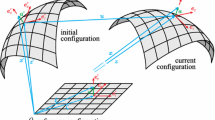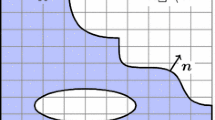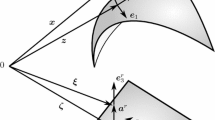Abstract
A direct method is proposed to solve large systems of linear algebraic equations that arise in using the finite-element method. The method suggests to subdivide the initial structure into nonoverlapping, deeply nested substructures. The subdivision is performed automatically by the nested dissection method. Initially, the structure is subdivided into isolated finite elements. The solution process is step-by-step assembly of subsystems with simultaneous elimination of unknowns for completely assembled ones. The efficiency of the method is demonstrated by comparing it with the incomplete Cholesky conjugate-gradient method and the traditional envelope method as applied to a circular cylindrical shell with high ribs
Similar content being viewed by others
REFERENCES
S. N. Bakhvalov, N. P. Zhidkov, and G. M. Kobel'kov, Numerical Methods [in Russian], Nauka, Moscow (1987).
A. George and J. W.-H. Liu, Computer Solution of Large Sparse Positive Definite Systems, Prentice Hall, Englewood Cliffs, New Jersey (1981).
S. Pissanetzky, Sparse Matrix Technology, Acad. Press, New York (1984).
A. A. Samarskii and E. S. Nikolaev, Methods for Solution of Mesh Equations [in Russian], Nauka, Moscow (1976).
S. Bitzarakis, M. Papadrakakis, and A. Kotsopulos, “Parallel solution techniques in computational structural mechanics,” Comp. Meth. Appl. Mech. Eng., 148, 75-104 (1997).
G. D. Gavrilenko, “Stability of cylindrical shells with local imperfections,” Int. Appl. Mech., 38, No. 12, 1496-1500 (2002).
G. D. Gavrilenko and V. I. Matsner, “The stability and load-carrying capacity of cylindrical shells with axisymmetric dents,” Int. Appl. Mech., 38, No. 7, 861-871 (2002).
Ya. M. Grigorenko and A. T. Vasilenko, “Some approaches to the solution of problems on thin shells with variable geometrical and mechanical parameters,” Int. Appl. Mech., 38, No. 11, 1309-1342 (2002).
I. S. Duff and J. K. Reid, “The multifrontal solution of indefinite sparse symmetric linear equations,” ACM Trans. Math. Software, 9, 302-325 (1973).
I. S. Duff, “Parallel implementation of multifrontal scheme,” Parallel Comput., 3, 193-204 (1986).
I. S. Duff, J. K. Reid, and J. A. Scott, “The use of profile reduction algorithms with a frontal code,” Int. J. Num. Meth. Eng., 28, 2555-2568 (1989).
S. Yu. Fialko, “The high-performance assembly element-by-element iterative solver for the large-scale complex shell structural problems,” Arch. Civil Eng., 35, No. 2, 193-207 (1999).
S. Yu. Fialko, “High-performance assembly element-by-element Ritz-gradient method for structure dynamic response analysis,” CAMES, 7, 537-550 (2000).
S. Yu. Fialko, “High-performance iterative and sparse direct solvers in Robot software for static and dynamic analysis of large-scale structures,” Proc. 2nd European Conf. on Computational Mechanics, Cracow, Poland, June 26-29 (2001), p. 18.
P. Gend, J. T. Oden, and R. A. Van der Geijn, “A parallel multifrontal algorithm and its implementation,” Comp. Meth. Appl. Mech. Eng., 149, 289-301 (1997).
B. Irons, “A frontal solution of program for finite element analysis,” Int. J. Num. Meth. Eng., 2, 5-32 (1970).
C. E. Jauglard and A. L. G. A. Cartiho, “A comparison of iterative multi-level finite element solvers,” Comp. Struct., 69, 655-670 (1998).
M. Papadrakakis, Solving Large-Scale Problems in Mechanics, John Wiley and Sons, New York (1993).
J. A. Scott, “On ordering elements for a frontal solver,” Comp. Num. Mech. Eng., 15, 309-323 (1995).
J. A. Scott, “A parallel frontal solver for finite element applications,” Int. J. Num. Meth. Eng., 50, 1131-1144 (2001).
V. A. Zarutskii, “The theory and methods of the stress-strain analysis of ribbed shells,” Int. Appl. Mech., 36, No. 10, 1259-1283 (2000).
O. C. Zienkiewicz and R. L Taylor, The Finite Element Method, 4th ed., Vol. 1, McGraw-Hill, New York (1989-1990).
Author information
Authors and Affiliations
Rights and permissions
About this article
Cite this article
Fialko, S.Y. The Nested Substructures Method for Solving Large Finite-Element Systems as Applied to Thin-Walled Shells with High Ribs. International Applied Mechanics 39, 324–331 (2003). https://doi.org/10.1023/A:1024474621617
Issue Date:
DOI: https://doi.org/10.1023/A:1024474621617




